The roles of entrepreneurs and online marketers have become more dynamic and research-oriented to get sales online in this crowded and ever-evolving digital landscape.
Gone are the days when you can just put your website live and expect leads to come quickly. Earlier, you could use platforms like social media, email, search engine, and PPC, where you can advertise your brand straight away and generate business easily.
Now, you have to utilize those channels calculative to get good results for your marketing efforts, as so many businesses are competing in the same niche.
So, a funnel is a must-have marketing tool for businesses to build an audience that converts.
Why Should You Make High-Converting Funnel?
A funnel provides you a guiding path to engage users and make them your customers. Funnel will intelligently clear all the roadblocks to delight relevant prospects and make them your brand ambassadors.
Through a robust funnel, you can effectively utilize your content marketing efforts to get the best results for your brand. A funnel can generate a stream of new leads for your business.
Although more than 70% of leads are not ready to get converted into customers. So, instead of focusing on quantity, rely on the quality of the leads.
Therefore, instead of creating just a funnel, a high-converting funnel can help you filter the prospects and target the best ones.
A high-converting funnel will help you align your content marketing efforts to promote your brands in such a way to communicate with relevant prospects and turn them into buyers effectively.
Plus, your content distribution would be laser-focused. Hence, your brand would be present on the right channel at the right time instead of being present everywhere all the time when your buyers might not be present. A high-converting funnel also takes care of the lead nurturing.
That means it is a process of establishing and maintaining relationships with your prospects and customers.
In a nutshell, a high-converting funnel will keep giving you top-quality leads and help you save time and resources by implementing laser-focused targeting methods.
9 Useful Tips To Build A High-Converting Marketing Funnel
Today, I’m going to discuss how you can create a high-converting marketing funnel for your brand. Before we dive into the simple step-by-step process, understand that a prospect goes through several stages of awareness to become a customer.
- Unaware: Users don’t even know they have a problem.
- Pain Aware: They know something is wrong, and they want a solution for it.
- Business Aware: They come across your business and know about the products.
- Solution Aware: They are on the verge of making purchasing decisions from your business.
Hence, your content would revolve communicating to only those prospects who are at a particular stage of awareness in your funnel. For example, content for people at an unaware stage would be different from business aware or solution aware.
So, without wasting time, let’s understand how to build such a funnel.
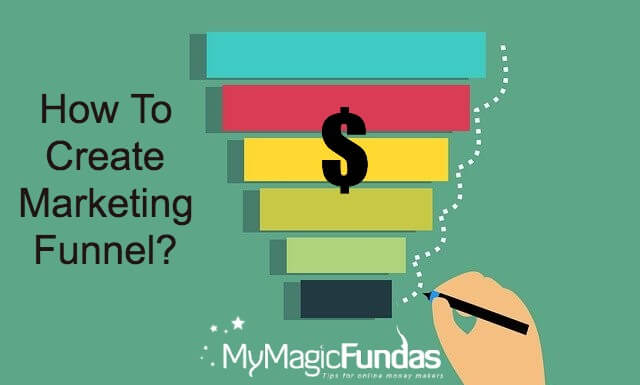
Step 1: Understand Customers
To filter out your existing content or brainstorm new ideas, you need to know most things about your customers to develop content that resonates with them. 73% of customers say that they are frustrated by finding irrelevant content on a website.
Understanding customers will help you give them personalized and memorable user experience on your landing pages, website, articles, videos, etc. So, they would keep visiting your page and interact more with your brand.
To start knowing them, understand their daily challenges to understand how your products can help them solve those miseries. You must know where they go, online or offline, to find solutions and cope with problems that your products solve.
That’s when you will get the opportunity to pitch your services and products to them through different formats of platforms and content. The best way to start prospecting your customers is to create a buyer persona. It is a representation of your ideal buyer. Create a buyer persona that must below details of about your consumer:
- Location
- Gender
- Behaviors
- Personality
- Hobbies
- Likes and dislikes
- Age group
- Occupation
- Designation
- Monthly or yearly income (approx.)
Then you can align the stages of awareness with the buyer persona to determine which channels, social media platforms, or resources they use at a particular stage of knowledge.
This data will give an idea about
- What are their main problems?
- How are they currently solving those problems?
- What are their satisfaction and dissatisfaction?
- What social media platforms they use regularly?
- What bloggers do they follow?
- Who is their favorite celebrity?
- What is their favorite pass-time activity?
- How do they gather knowledge about your industry?
- The list can go on
This will provide you a good idea about utilizing different channels and target users at various stages of awareness.
Step 2: Research The Market
Researching the market is the first step to design your funnels. In this step, you have to observe your competitors.
Of course, I’m not implying to copy anyone. Understanding of other brands interacting with their users will give you inspiration for your funnel development. Have a look at social media accounts, websites, and sales pages to see how they entertain their prospects.
- How have they written their content?
- What creatives have they used?
- What type of message are they communicating?
- What USPs have they mentioned?
- What value-proposition have they written?
These answers give you an idea of what users are used to seeing on the web. It might happen some of your competitors have not even applied the funnel, and you will realize it as you check out their content.
Step 3: Finalize Channels And Content Formats
This is where things get critical and creative. Now, you will have to define the platforms and channels that you are going to use. Based on the awareness stage of the buyer, you will utilize a specific channel and leverage a particular content type.
Say, your buyer goes to YouTube to find a solution that products provide so that you can use in-stream YouTube video ads. Here, your channel will be Google display ads, and the format will be videos. Major channels are:
- Social media
- Search engine
- Website
Formats could be:
- Image
- Text
- Infographic
- Podcast
- Webinar
- Course
- eBook
- Video
The list goes on!
These channels and formats can help you generate brand awareness of your products. They will also help you pursue and convert prospects into buyers. When you are creating brand awareness, you can share images and infographics on social media platforms.
If you are acquiring leads, pursue them through a dedicated landing page on a website using a webinar or an eBook. Irrespective of the channel and format that you use. Make sure you are using persuasive language to make people stick with your content.
Make your content engaging by pinpointing solutions to your products or pains of the users. Your visitors would quickly relate to the first lines that you write. If your content is boring, you will fail to grab users’ attention, and they will scroll away.
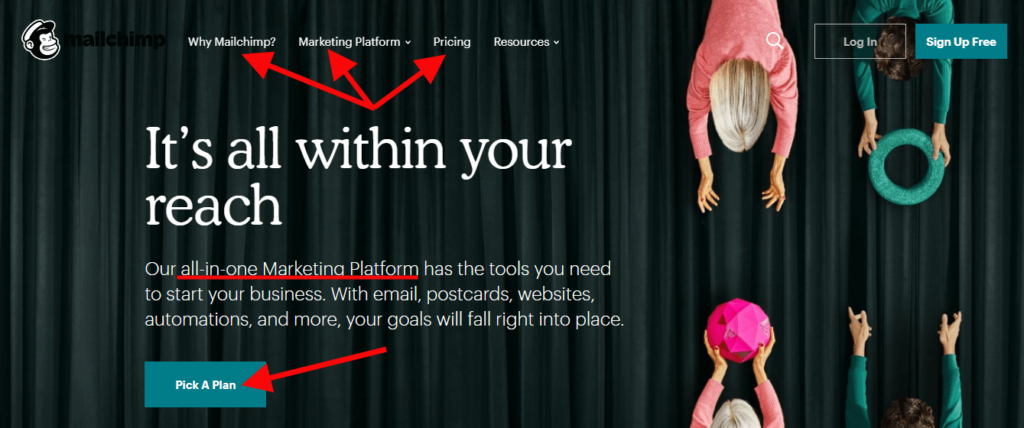
See how Mailchimp has put everything — menu, headers, buttons, words into place on the homepage to engage relevant users effectively. Most importantly, make sure that you include a relevant call-to-action at a particular stage of the funnel. 9 out of 10 customers who read your headline would also read your CTA, so make sure you use a smart one.
The CTA would give that hook and move the prospects to the next stage of the funnel.
Step 4: Engage With Your Audience
As a part of the funnel building, engage with your audience, the more, the better. It will make them feel that their comments are being taken seriously. Plus, it will help your posts get more engagement on social media channels.
Remember that a funnel will only work if you strive to provide a great user experience to your prospects. Commenting on their posts mentioning your brand, liking their posts, retweets, comments, and reacting to their comments on Instagram and Facebook go a long way in optimizing your funnel by giving a good user experience.
Make sure that these interactions are personalized because personalization builds trust. And 73% of buyers say that trust matters than it used to be a couple of years ago while doing business with companies.
These personalized interactions, while managing a funnel, will help your brand get a high trust factor in the targeted market.
While reacting to customers, use the language they speak while interacting with them. I love how Netflix engages with its audience on comments on Instagram.
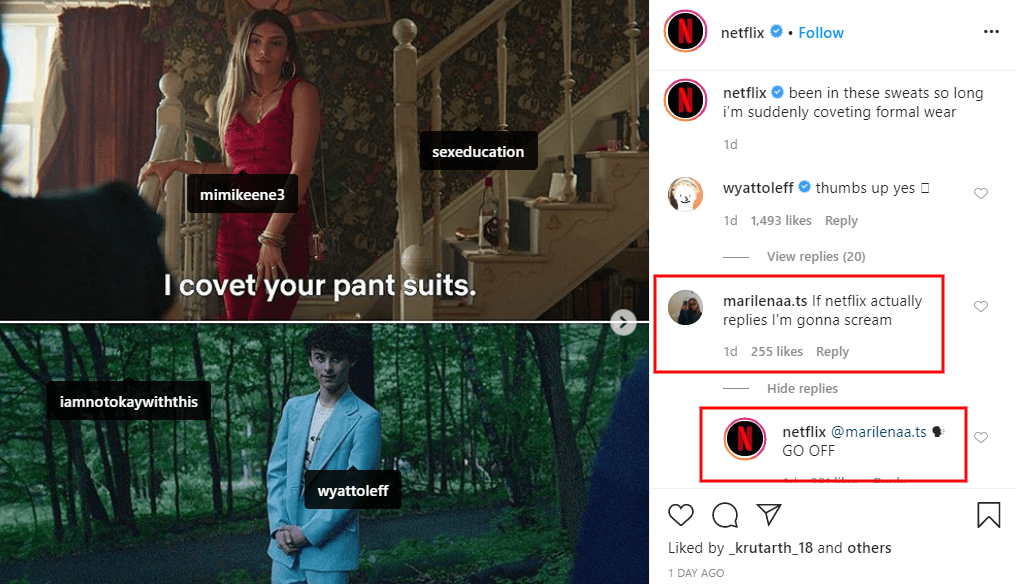
Step 5: Showcase Your Value-Proposition
Ensure to highlight the value proposition at the beginning of your content. As people’s attention span is decreasing in this era, try to be as direct as possible. Depending on the awareness stage and content you are using, you will have to re-define the crux of your value proposition and showcase it to users.
Identifying the pain points and showcasing them with products and services is a great way to do so.
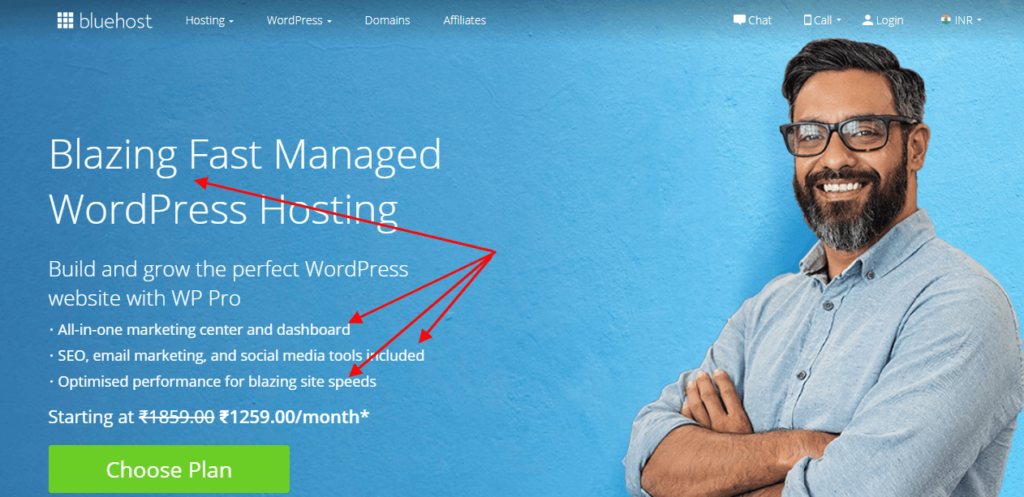
See how Bluehost is promoting its WordPress hosting through different headlines, bullet points, and a vector image of a gentleman. You can leverage different sections at your landing page to mention your value proposition.
Get a heatmap of your website to understand where users focus their attention while browsing through the web. Now, try to reposition your value prop through different formats of content on those highly-focused areas to get maximum engagement.
Step 6: Get Users’ Information
This is the necessary element that you have to include in your funnels. You want your customers to interact with you on a more personal level so you can explain their solutions and pursue them more effectively.
Even if your prospects don’t buy your stuff at that particular instance, you can keep sharing your emailers and data on their email addresses. To do that, you will need the data that you can acquire through lead generation tactics. Include forms at relevant places to get the data of the prospects.
Now brands mutually enter just email address and number without entering any more details. You can keep your forms general and include fewer fields. But if you are at the later stages of the funnel, try to get more information out of the prospects.
If you have more data, you can give them personalized solutions that will increase the chances of conversions.
On your landing pages, you can also add a website popup that comes whenever a user tries to get out of your page. This will help your website get more session time, and you may get users’ data before they leave your site.
Other reasons to get users’ data:
- Offer discounts.
- Provide value (eBooks, webinars, videos, etc.)
- Give a trial period.
- Give one-to-one sessions.
Step 7: Help Them To Make A Decision
By now, your users would have heard about your brand and probably provided information to you. Now, it is your job to stay in communication with them and give an offer that they cannot refuse.
You can run a series of email conversations and share your knowledge and expertise with prospects. Make sure to build trust by providing unparalleled value to your potential buyers.
At this stage of the funnel, you can use paid Facebook or Google ads to retarget website visitors. Add Facebook Pixel and Google’s code snippet to record interactions of users and then further target them.
Here, you have to be very clear through your copy. Remember that your customers have already visited the website or interacted with you. So, write persuasive copy in such a way to make people take final decisions in your favor confidently.
Step 8: Give Superior Post-Conversion Interaction
Once your users are converted, your job is not over. Now it is your chance to make your new customers your brand ambassadors.
You have a golden opportunity to provide a world-class experience so that users don’t go with other products or services and end up referring your products to their contacts. Remember that building more business out of your clients is what separates other funnels from a high-converting one.
Make sure you have as your full-proof client onboarding process. You can also provide them offers for your products. You can give them early-bird access to your upcoming products and services. Also, include a referral bonus for your existing customer who brings a new customer for your brand.
Step 9: Use Clickfunnels
There are so many tools that you can use to create high-converting marketing funnels for business. My personal favorite is Clickfunnels. It has got everything that you can ask for to market, sell, and deliver your products and services online.
Whether you want to increase your eBook downloads, video views, sell eCommerce or SaaS products, get webinar registrations, Clickfunnels is ideal for almost every objective.
It helps you create landing pages powered by a world-class funnel.
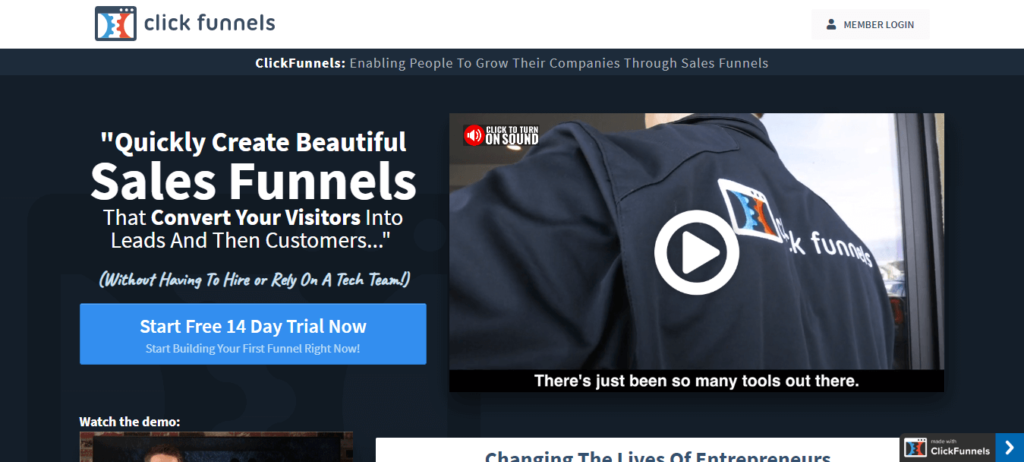
It has got a simple drag-and-drop web page editor to create responsive and elegant landing pages to entertain your prospects.
You can also enable one-click to upsell features to generate more return on investment for activities. You can get an automatic email and Facebook marketing activities using Clickfunnels.
Most importantly, all these features are clubbed together on a single dashboard. So, you don’t have to jumble across different browser tabs. If you want to go omnichannel, you can enable quick follow-ups and send personalized text, email, social media messages, and desktop notification to your target customers. Plus, it provides a 14-day free trial.
If you can’t afford this tool, then you may check the best ClickFunnels alternatives and pick the best leads to maximize your leads and conversions.
Wrapping Up
So, let me know what your thoughts about the ideas discussed in this blog are. I hope you have found this article helpful. I’d recommend you to try Clickfunnels for 14 days and build a funnel with the points shared above. Either way, let me know in the comments below if I’ve forgotten to add something.

In today’s competitive market, everyone wants to generate business from websites but mostly people don’t achieve that target due to lack of knowledge. I saw your post in which you sharing us lot of knowledge regarding High-Converting Marketing Funnel; it will definitely help to those people who are unaware these techniques so thanks Nirmala for providing detailed tips of Converting Marketing Funnel.
Funnel are important for Converting. Thanks for your nice post on this. It will help me.
Thank you for sharing this post about creating effective marketing funnels!
This is a part of blogging I still need a lot of work in. I enjoy writing content and helping people first and foremost, so I often make the mistake of not considering conversions as much as I should or as early in the process as I should.
This is a good reminder to start placing more priority on my marketing and conversion efforts.
Thank you again!
I had weaknesses about high conversion in my business. thank you for these suggestions. I will try.
Funnels are the most important thing, no matter how your product value is, without a high converting funnel no one will become your customer. Like you said clickfunnel is highly recommended!
Nirmala your blog post so helpful for me
though I had heard about the importance of funnels, I didn’t actually understand much about them. thank you for explaining in a simple way.
Nice article. I liked it so much.
Thanks for the post.
Keep up the good work
The post is absolutely fantastic! Lots of great information and inspiration both of which we all need! Also like to admire the time and effort you put into your blog.
Not only how you’ve explained that why anyone should make high-converting funnel is easy to comprehend, but the nine tips and its explanation have been very much insightful.
thanku nirmla mam
the idea you give in this article about funnels is amazing.
online earning opportunities provided by you in this article are great.